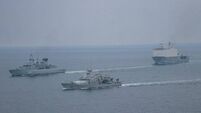Probe into Irish cargo plane accident in East Midlands

A Boeing 737-400F cargo plane, operated by Dublin based Air Contractors Ltd, forced the closure of the airport yesterday morning after the jet was left crippled on the runway.
The two wheels from the left side undercarriage were found some distance from where the aircraft came to a stop.












